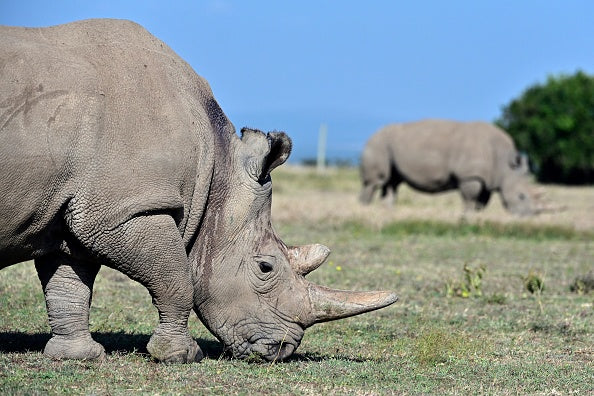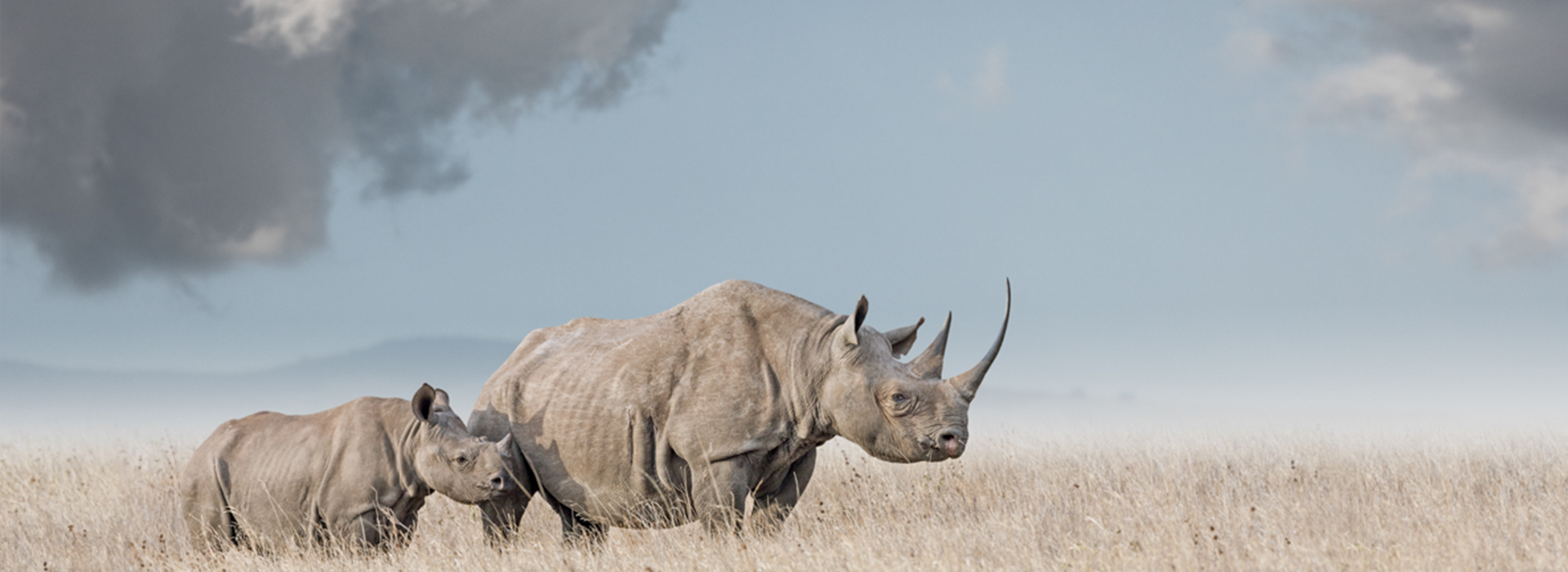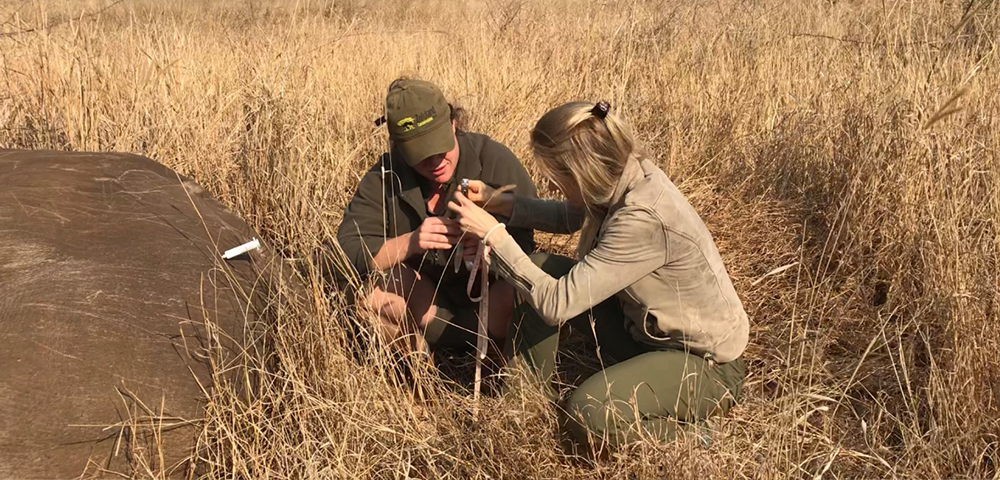White rhinoceros | Population, Habitat, & Facts

Scientific name
Ceratotherium simum - the word Ceratotherium is derived from the Greek word “cerato”, which means “horn” and “thorium”, which means “wild beast” while “simum” is from the Greek simus, meaning “flat-nosed.”
Subspecies
- Northern white rhinos
- Southern white rhinos
Population
There are currently less than 16,000 white rhinos.
Biology

The white rhinos are also known as the square-lipped rhino because of their square upper lip. They were originally referred to as Wyd rhinos, an Afrikaans word that referred to the size of their mouth which was very wide. It later became known as the white rhino after Foreigners thought it was white and mispronounced the word as white. The name stuck.
The white rhinos are found in Africa in two different regions both with similar characteristics of having long and short-grass savannahs.
99% of the white rhinos are contained in five countries, most of which are South African countries. These animals are grazers which explain their habitat. Its wide, square upper lip is adapted for feeding on grasses.
White rhinos can live to be 35-40 years of age. Gestation lasts approximately 16 months, and mothers give birth to one calf every 2-3 years.
White rhinos are semi-social and territorial. Females and subadults generally are social, but the male rhinos also known as bulls are often solitary.
Physical description
The white rhinos are the second largest land mammals with zero hair. Elephants being the first. Compared to black rhinos, white rhinos have a longer skull, a less sharply defined forehead, and a more pronounced shoulder hump. The white rhinos have heads that hang down close to the ground and only look up when startled; they also have a broad snout with a square tip. They also have almost no hair and possess two horns. The front horn averages 60 cm but occasionally reaches 150 cm in length.
Bull adult male
Adult male rhinoceros are about 1.85m in height and weigh a whopping 3.6 tonnes.
Adult females
The adult females however are comparably smaller at 1.7 tonnes.
Skin color
Despite their names, there is no difference in the skin color of the white and black rhinos.
Hair
The White rhinos have hair only on ears, tail tips, and eyelashes.
Horn
White rhinos have two horns. The larger front horn measures 37 – 79 inches (94 – 201 cm) while the rear horn measures up to 22 inches (55 cm) long.
The white rhino is a major conservation success story, having been brought back from the very brink of extinction. But the current surge in poaching for their horns, particularly in South Africa, has seen record numbers killed in recent years. Urgent efforts are now underway to stop poaching and end the illegal.

Habitat
They primarily inhabit grassy savanna and woodlands interspersed with grassy clearings.
The Southern white rhino can be found mostly in South Africa, with smaller translocated populations found in Kenya, Namibia, and Zimbabwe.
Diet
The White rhinos are the only grazer among the five rhino species, feeding almost exclusively on short grasses.
Social behavior
The White rhinos are sedentary, semi-social, and territorial. The bulls ( adult males) are solitary and associate only with females in heat. The female rhinos are more sociable and form groups with their daughters or with neighboring female rhinos. Stable groups known as ‘crashes’ are also formed which comprise about six rhinos while larger groups could be formed due to situations such as temporary aggregations, availability of food, water, or resting conditions.
Life cycle
The Female rhino reaches sexual maturity at around 6-7 years old, while males can only form a territory or get a mate when they are 10-12 years old When the bull approaches its heat it finds its mate and courts her for a day before which he must have followed her for three weeks prior at a close distance. The courting involves the male resting his chin on the female’s rump and attempting mounting. Then later the female rhino stands still, with its tail curled, and allows copulation. Mating is remarkably prolonged, lasting from 20 minutes to one hour.
This copulation brings about gestation which lasts 16 months or thereabout. The interval between calving is 3-4 years. Pregnant females will leave their crash shortly before the parturition and stay apart for several days afterward. Calves stand up within one hour, immediately attempting to suckle. Mother and calf become inseparable; the calf usually moves in front of its mother and immediately responds to the mother’s behavior. The calf begins grazing at two months, weaning occurs at around one year of age. The calf stays with its mother for around three years. The calf then matures and lives for forty to fifty years.

Behavior
White rhinoceroses feed and rest alternately during the day and night. In hot, dry weather they routinely rest during the hottest part of the day. Much of their resting time is spent wallowing in water or mud to keep cool and to get rid of skin parasites. The white rhino needs water for drinking every 2-4 days. If there is no wallowing place available, they will roll in dry dust.
The rhinos tend to wallow in the mud, which serves as a cooling technique, effective sun protection, and insect repellent. After wallowing, the visual color of the animal inevitably matches the color of the local soil
Running speed
The white rhinos are very agile and can run very fast, up to 40 km/h. They are usually active in the early morning, late afternoon, and evening.The white rhinos tend to avoid the heat during the day when they rest in the shade. During very hot periods, they cool and rid themselves of external parasites by bathing in mud in shallow pools 'wallowing'.
How threatened are they?
The white rhino is threatened by extinction. With the Southern white rhino having a population of close to 16,000 individuals, the Northern white rhino is however critically Endangered with only two individuals left, living at Ol Pejeta Conservancy. The number of white rhinos reduced greatly due to poaching.
References
https://www.worldwildlife.org/species/white-rhino
https://rhinos.org/about-rhinos/rhino-species/white-rhino/
https://www.bbc.com/news/world-africa-52228181
https://www.savetherhino.org/thorny-issues/can-we-save-the-northern-white-rhino/
https://www.savetherhino.org/rhino-info/rhino-species/white-rhinos/


